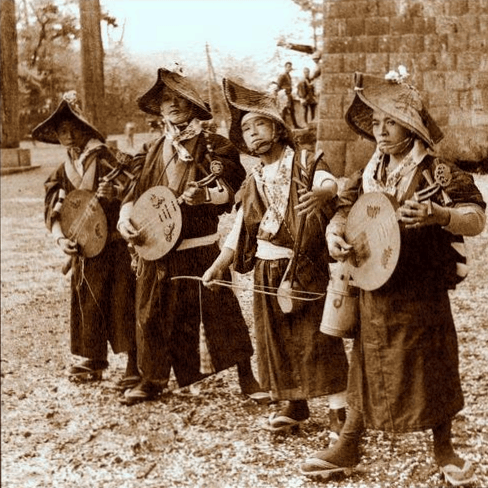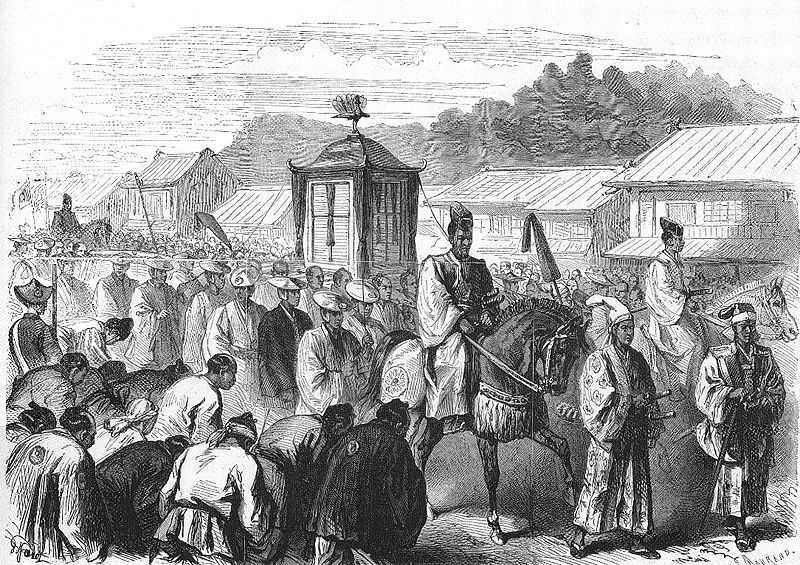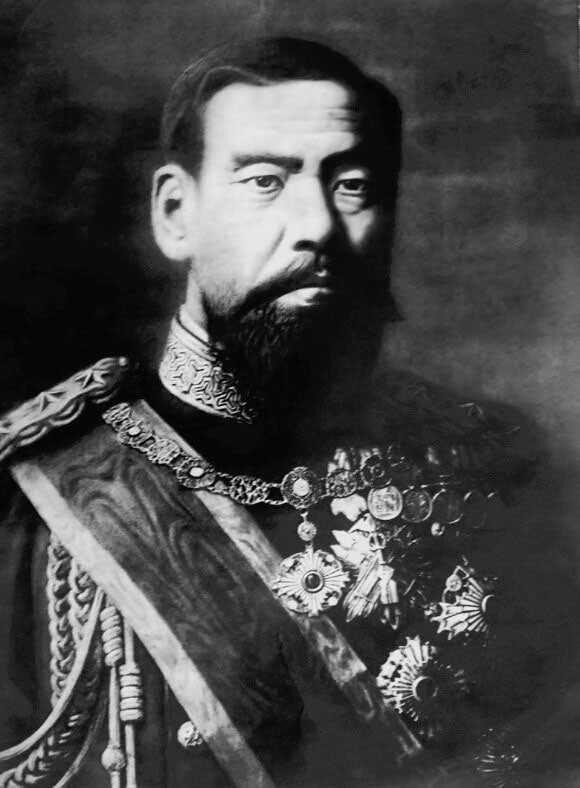
![]() Reiwa – Heisei – Showa – Taisho – Meiji
Reiwa – Heisei – Showa – Taisho – Meiji
The Meiji period (明治時代 Meiji-jidai), also known as the Meiji era, is a Japanese era which extended from September 1868 through July 1912. This period represents the first half of the Empire of Japan. During this time society moved from being an isolated feudalism system to its modern form. Fundamental changes affected its social structure, internal politics, economy, military, and foreign relations.
Meiji restoration and the emperor
Learn about Japan’s Meiji period (September 1868-July 1912), significant cultural, political, & economic changes that occurred. Discover how the Meiji Emperor & government modernized/industrialized Japan, transforming it into a major world power.
Main article: Abolition of the han system
On February 3rd, 1867, fifteen-year-old prince Mutsuhito succeeded his father, Emperor Kōmei, to the Chrysanthemum Throne as the 122nd emperor.
Imperial restoration occurred the next year, on January 3rd, 1868, with the formation of the new government. The Tokugawa Shogunate was overthrown with the fall of Edo in the summer of 1868, and a new era called Meiji, meaning “enlightened rule”, began.
The first reform was the promulgation of the Five Charter Oath (五箇条の御誓文, Gokajō no Goseimon) in 1868, a general statement from the Meiji leaders that aimed to boost morale and win financial support for the new government. Its five provisions consisted of
- Establishment of deliberative assemblies
- Involvement of all classes in carrying out state affairs
- The revocation of sumptuary laws and class restrictions on employment
- Replacement of “evil customs” with the “just laws of nature” and
- An international search for knowledge to strengthen the foundations of imperial rule.
Implicit in the Charter Oath was an end to exclusive political rule by the bakufu and a move toward more democratic participation in government. To implement the Charter Oath, leaders drafted a constitution with eleven articles. It established a new Council of State, legislative bodies, and systems of ranks for nobles and officials. The constitution also limited office tenure to four years, allowed public balloting, introduced a new taxation system, and imposed new local administrative rules.
The Meiji Government
The Meiji government assured the foreign powers that it would follow the old treaties negotiated by the bakufu. It announced that it would act in accordance with international law. Mutsuhito, who was to reign until 1912, selected a new reign title—Meiji, or Enlightened Rule. This was to mark the beginning of a new era in Japanese history. To further dramatize the new order, the capital was relocated from Kyoto, where it had been situated since 794. It was relocated to Tokyo (Eastern Capital), the new name for Edo. In a move critical for the consolidation of the new regime, most daimyo voluntarily surrendered their land and census records to the emperor in the abolition of the Han system, symbolizing that the land and people were under the emperor’s jurisdiction.
Trivia: Kyo to → To kyo
It looks like they just switched 2 parts of the name from Kyo-to to To-kyo in English but that’s not what happened.
Kyoto: 京都
Kyoto’s kanji translate to capital (京) where the Emperor lives (都).
Tokyo: 東京
Tokyo means “eastern (東) capital (京)”.
The character 京 (jīng in Chinese) originated as a pictographic symbol representing a man-made mound with an observation tower on top of it, used for political observation.
The top “亠” part of the character is the shape of a roof of a building on a high ground.
“口” is a castle wall around the settlement or capital.
The “小” part represents the small hill.
Since ancient times, people have preferred living on higher grounds where floods weren’t a problems and settlements on such grounds later on usually became the main cities. Hence we have this character.
The character 京 gives a sense of “an elevated place” at its root.
The Meiji Restoration and the end of the Tokugawa shogunate in 1867: The fifteen-year-old Meiji Emperor, moving from Kyoto to Tokyo, at the end of 1868, after the fall of Edo.
Confirmed in their hereditary positions, the daimyo became governors. The central government assumed their administrative expenses and paid samurai stipends. In 1871, prefectures replaced the han and authority continued to flow to the national government. Officials from the favored former han, such as Satsuma, Chōshū, Tosa, and Hizen staffed the new ministries. Formerly out-of-favor court nobles and lower-ranking but more radical, samurai replaced bakufu (tent government) appointees, daimyo and old court nobles as a new ruling class appeared.
What is a daimyo/shogun?
At the top of Japanese feudal society was the shogun. The shogun were the vassal lords, known as daimyo [DIME-yo]. The daimyo were large landholders who held their estates at the pleasure of the shogun. They controlled the armies that were to provide military service to the shogun when required.
Emperor Meiji in his fifties
(Syncretism is a union or attempted fusion of different religions, cultures, or philosophies — like Halloween, which has both Christian and pagan roots, or the combination of Aristotelian philosophy with the belief system of the early punk rock practitioners. )
As the Meiji Restoration aimed to restore the emperor’s central role, leaders began building a Shinto-based state similar to the one that had existed 1,000 years earlier. However, because Shinto and Buddhism had blended into a syncretic belief over the centuries, they needed to separate the two and construct a new form of State Shinto. To do this, they created the Office of Shinto Worship, which even outranked the Council of State.
At the same time, the government embraced the kokutai ideas promoted by the Mito school. These beliefs centered on Japan’s unique national identity, rooted in the emperor’s divine ancestry, the unbroken imperial line, and the unity of the people with the state. By supporting this ideology, leaders aimed to strengthen loyalty to the emperor and justify centralized rule. They also paid/funded Shinto teachers to help promote these values nationwide.
Although the Office of Shinto Worship lost its high status in 1872, by 1877 the Home Ministry had taken full control of all Shinto shrines. In addition, officials granted recognition to certain Shinto sects, removed Shinto from Buddhist control, and restored its property. While Buddhism lost official support, it experienced a revival. Christianity was legalized, and Confucianism remained an important ethical influence. Over time, more intellectuals began to align themselves with Western thought and modern methods.





Comments